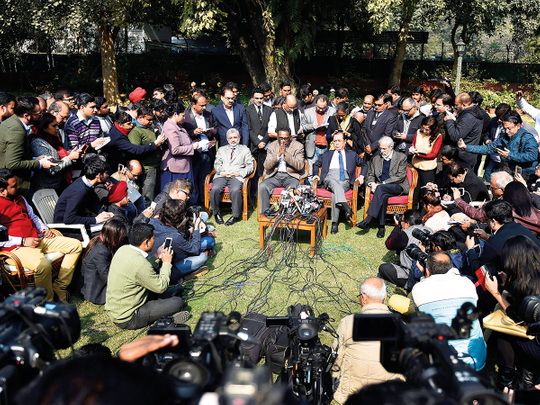
New Delhi: India’s Supreme Court entered 2018 on a tumultuous note, with the country’s four most senior judges going public on January 12 with protests over its functioning and the allocation of cases.
What was not said then was recently revealed by Justice Kurian Joseph — one of the four “rebel judges” — that they felt the then Chief Justice Dipak Misra was being “controlled from outside”.
The press conference by the four judges, including Ranjan Gogoi, who was elevated to Chief Justice later in the year, created ripples in judicial and political circles which Justice Amitava Roy said left the top court with a “fractured face” and dented its credibility and the primacy of the judicial process.
The memory of the “sensational press conference”, senior counsel K.V. Vishwanathan said, has fortunately receded to the background because of the import of a series of judicial pronouncements through the year pushing to forefront the doctrine of “constitutional morality”, “gender justice” and the limits of state intrusion in the private domain of citizens, to mention just a few issues.
However, activist-lawyer Prashant Bhushan said “nothing much has changed” except that the allocation of cases to different benches is better and things are “not as bad as in the past.”
Master of Rolls
Buttressing his argument, Bhushan said the chief justice continues to be the Master of Rolls and Public Interest Litigations are not being listed before the benches headed by the five most senior judges of the top court and were largely confined to the court of the chief justice.
The last assault, as it were, in this chain of events was the failed attempt by the Congress to initiate the impeachment of the then Chief Justice Misra — a move that had few takers in judicial circles as some former judges felt that there was no merit in the move.
However, senior advocate Kapil Sibal asserted that the grounds for the impeachment were “justified” and not “frivolous” as he sought to dispel the impression that he was the inspiration behind the move.
It was moved by the “Congress party and 50 MPs signed it”, Sibal maintained.
Assessing as “average” the top court’s performance in 2018, senior counsel Dushyant Dave took a dim view of its failure to even order an inquiry into the sad demise of Judge B.H. Loya — who was conducting the trial on the alleged staged shoot-out of Sohrabuddin Shaikh, killing of his wife Kausarbi and encounter of his associate Tulsiram Prajapati in 2002.
(All the 22 accused in the case were acquitted earlier this year. Amit Shah, then the Gujurat Home Minister and now the BJP President, was at one time named in the case but was later discharged.)
“The year 2018 has been one of the darkest chapters in the history of the Supreme Court. The abject failure of the Court in even ordering an inquiry into the sad demise of Judge Loya reflects the lack of independence on its part. The court missed a golden opportunity to send a powerful message to subordinate judiciary, the backbone of the administration of justice, that it stands by them, come what may,” Dave told journalists.
Hailing the emergence of the “doctrine of constitutional morality and the triumph of gender justice”, as its “crowning glory”, Vishwanathan said the court has in “no uncertain terms asserted that there is no place in our country, for what I may say, the ‘hecklers of morality’”.
“Vested interests, under the guise of social morality” had been “attempting to undermine valuable constitutional rights of the individuals,” Vishwanathan said, adding that women and the marginalised “will no longer be subjected to moral policing of the others’ notions of morality”.
Victorian Morality was buried nine fathoms deep,” he asserted.
Some recent appointments, transfers and elevations in higher judiciary by the top court’s collegium did raise eyebrows.
Its functioning was “far from satisfactory” and “hugely disappointing”, Dave said.
Pointing to the flaws in the selection of judges for appointment to higher judiciary, Dave faulted the collegium’s seniority-centric approach and not picking “the best from among those available” as mandated by the court’s own judgements.
Aadhaar verdict
The year also saw the court telling the government that Aadhaar was not a panacea of all that ails governance, while restricted officials from demanding the Unique ID (UID) number for each and every scheme.
Another area of serious concern, where the top court left its indelible stamp, was the environment. It was unsparing in hauling the administration for not doing enough for curbing an alarmingly high level of air pollution and the handling of the piling mound of solid waste.
Describing the ban on the use of pet coke and furnace oil in the NCR as a “huge, huge step”, Supreme Court lawyer and amicus curiae in environmental matters Aparajita Singh said the court’s order had blocked American petroleum coke from reaching India’s shores after China banned it.
Referring to the several order of the court relating to environment which were not being acted upon by the authorities on the ground level, Aparajita Singh said: “The consistent monitoring of the implementation of its orders infused fear among the authorities and they fell in line and started acting on them.”
Other landmark judgements during the year were advancing the deadline for the introduction of BS VI fuel from 2024 to April 1, 2020 across the country, issuing long-awaited guidelines on witness protection, guarding the identity of the victim of sexual assault and rape including the rehabilitation of the victim and payment of compensation.












